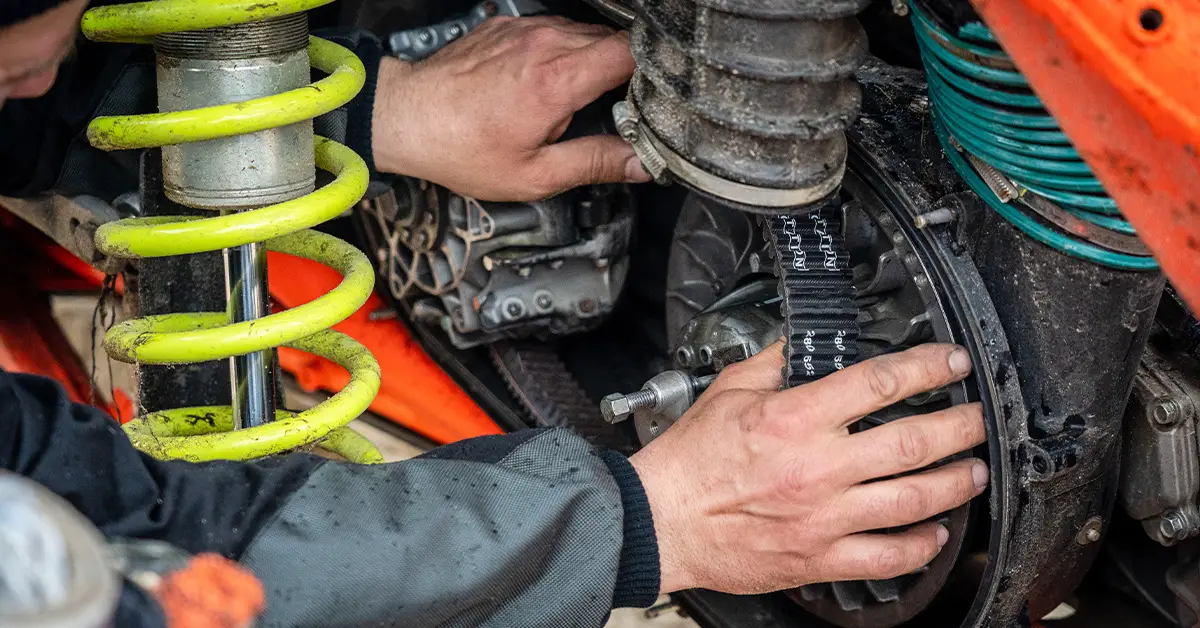When you are out on the market looking to buy the best ATV, there are certain factors that you have to consider. And, one of them is the kind of drive system that you should choose. You have heard people talking about shaft drive, belt drive, or chain drive.
But remain confused about these terminologies. So, what ATVs are belt driven? And, what are shaft driven? This post helps clarify these terms and provides you with an overview of the same. Also, you get to know about their benefits and drawbacks. So, let’s get started.
Table of Contents
What are shaft drive and belt drive?
These days, most of the recreational ATVs that you see on the market have a shaft-driven system. It means the vehicle uses metal drive shafts to transfer power to the wheels from the transmission. And, it includes ATVs with beltless alternatives from Honda and belt-driven CVT transmission.
So, why most ATVs are treated as shaft-driven? To understand that, you have to be clear about when someone talks about an ATV being belt-driven or shaft-driven, or chain-driven. These are the three terms that refer to the type of drivetrain that the vehicle use. However, the terms aren’t used in the same way when it comes to all types of vehicles.
Besides, they don’t refer to the same components that are present on the drivetrain as well. The drivetrain has every component needed to transfer power from the engine to the wheels and that includes the transmission as well. However, different ATVs have different components.
On the other hand, the driveline includes components that transfer the engine’s power to the wheels excluding the transmission. Most ATVs that you find these days on the market consist of two types of transmission systems.
- Continuously variable transmission or CVT – While a CVT can have a belt-driven system, it doesn’t make the ATV belt drive. Moreover, a CVT can have a chain drive system, which is rare on ATVs. But that doesn’t make the ATV chain drive.
- Geared transmission – In this type of transmission, the gearbox consists of metal shafts and gears. Again, that doesn’t make the ATV shaft drive. Also, ATVs with gearbox transmissions are either fully automatic, semi-automatic, or manual.
ATV models with belt-drive
In general, an ATV with a belt drive usually refers to CVT belt-driven transmission style. Moreover, most of the belt-driven ATVs are shaft-driven because they use metal axels and shafts to transfer power from CVT transmission to the wheels. Besides, confusion occurs when you compare the same on a motorcycle.
Keep in mind that belt drive in an ATV and the same in a motorcycle aren’t similar in any aspect. Some motorcycle manufacturers have models where the metal chain drive is replaced with a belt made of rubber. And, that makes their driveline belt-driven. But ATVs don’t use belts in their driveline apart from using them on CVT transmission.
Are all ATVs that you find around belt-driven?
Most of the ATVs that you find on the market use a belt-driven CVT transmission. However, it doesn’t mean that the belt is used to transfer power to the wheels from the gearbox. To achieve this thing, companies either use a shaft or chain along with an axel driveline. Besides, ATVs that don’t use a belt-driven CVT transmission system use a semi-automatic, manual, or manual gearbox with clutches and gears.
ATVs with belt-driven systems
Here are some ATVs that have CVT-style and use a belt system.
- Polaris General series
- Polaris Ranger series
- Polaris RZR series
- Can-Am Maverick series
- Can-Am Defender series
- Yamaha Viking series
- Yamaha Wolverine series
- Kawasaki Mule series
- Arctic Cat Prowler series
- Arctic Cat Havoc series
- Massimo
ATVs with shaft-driven systems
Here is the list of ATVs with the shaft-driven system.
- Polaris Scrambler series
- Polaris Sportsman series
- Can-Am Renegade series
- Can-Am Outlander series
- Yamaha Grizzly series
- Yamaha Kodiak series
- Kawasaki Brute Force series
- Honda Fourtrax Rancher
- Honda Fourtrax Rincon
- Honda Foreman series
Which one is best: Belt driven vs shaft-driven systems
Neither belt-driven systems are perfect nor are shaft-driven ones. Both of them have their benefits and drawbacks in terms of performance and maintenance.
Benefits of the belt-driven system
There is no denying that most ATVs you come across are belt-driven and there are certain benefits of having a belt-driven system. The first major benefit is that if your belt breaks, it is not that hard to fix it.
Performance-wise, ATVs with the belt-driven system are preferred because drivers don’t have to worry about the clutch pedal or what gear they are in. When you are in a belt-driven system, it gives you the best mileage and raw horsepower.
Drawbacks of belt-driven systems
Because the CVT system helps you get better gas mileage and not the best performance, you can face difficulties when going uphill. Many drivers complain that there is a gap of time between pressing on the gas and actual acceleration.
The lifespan of the belt is another major factor to consider. They can be delicate by any stretch and will perform to their best as long as they can. Besides, it is made of flexible rubber and needs replacement every 6 months, every 50 hours of driving, or very 1000 miles, whichever comes first.
Benefits of the shaft-driven system
A shaft-driven system provides a more direct connection between the driver and wheels. There is no waiting for the vehicle to accelerate, unlike the CVT systems. And, no horsepower is lost during the transition.
The Driveshaft is protected from dust and dirt because it is enclosed and the internal mechanism remains in clean oil. Other than a catastrophic event, shaft drive is going to last throughout the life of the ATV.
Drawbacks of shaft-driven systems
The shaft system is enclosed in a casing means that you can’t get to it if something goes wrong inside it. That way you can’t fix them while you are on a trail. On the belt drive system, you can replace the belt instantly but not with shaft-driven systems. Also, they aren’t energy-efficient compared to the CVTs.










